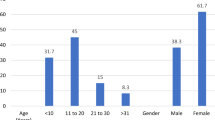Abstract
Adenoid hyperplasia is a common cause of nasal obstruction in the pediatric age group. Recently, the adenoids were shown to harbor Helicobacter pylori (HP) based only on the rapid urease test (RUT). We conducted this pilot study to identify the presence of HP in the adenoids histologically and assess the reliability of both the RUT and histology in detecting HP in an extragastric location, using nested (two-steps) polymerase chain reaction (nPCR). Consecutive patients undergoing adenoidectomy for obstructive adenoid hyperplasia were enrolled. Adenoid specimens were subjected to the RUT. Histological sections stained with hematoxylin and eosin, Giemsa and Warthin-Starry were examined. We then used nPCR to detect the presence of HP in the studied specimens. Twenty-five patients (3–10 years; mean of 5.5 years) were enrolled. Twenty-one (84%) adenoids were positive by the RUT. Seventeen (68%) had bacteria on histological sections; four (16%) contained HP-like organisms. However, all specimens were negative by nPCR. No patient had a history of symptoms suggestive of laryngopharyngeal reflux within 6 months of the study. In conclusion, the children enrolled in this study did not have HP in their adenoids. High false positive results can occur with the RUT when used on adenoid tissues. It is not possible to rely solely on morphology to detect HP in an extragastric location. The nPCR remains the best way to identify HP accurately, but does not imply its presence in an active role.



Similar content being viewed by others
References
Torrey J, Reese M (1945) Initial aerobic flora of newborn infants. AJDC 69:208–214
Brodsky L, Koch J (1993) Bacteriology and immunology of normal and diseased adenoids in children. Arch Otolaryngol Head Neck Surg 119:821–829
Mackowiak P (1982) The normal microbial flora. N Engl J Med. 307:83–93
Unver S, Kubilay U, Sezen O, Coskuner T (2001) Investigation of Helicobacter pylori colonization in adenotonsillectomy specimens by means of the CLO test. Laryngoscope 111:2183–2186
Bulajic M, Stimec B, Milicevic M, Loehr M, Mueller P, Boricic I, Kovacevic N, Bulajic M (2002) Modalities of testing Helicobacter pylori in patients with nonmalignant bile duct diseases. World J Gastroenterol 8: 301–304
Di Bonaventura G, Catamo G, Neri M, Neri G, Piccolomini R (2000) Absence of Helicobacter pylori in tonsillar swabs from dyspeptic patients. New Microbiol 23:445–448
Di Bonaventura G, Neri M, Neri G, Catamo G, Piccolomini R (2001) Do tonsils represent an extragastric reservoir for Helicobacter pylori infection. J Infect 42:221–222
Skinner LJ, Winter DC, Curran AJ, Barnes C, Kennedy S, Maguire AJ, Charles DA, Timon CI, Burns HP (2001) Helicobacter pylori and tonsillectomy. Clin Otolaryngol 26:505–509
Cirak MY, Ozdek A, Yilmaz D, Bayiz U, Samim E, Turet S (2003) Detection of Helicobacter pylori and its CagA gene in tonsil and adenoid tissues by PCR. Arch Otolaryngol Head Neck Surg 129:1225–1229
Yilmaz M, Kara CO, Kaleli I, Demir M, Tumkaya F, Buke AS, Topuz B (2004) Are tonsils a reservoir for Helicobacter pylori infection in children? Int J Pediatr Otorhinolaryngol 68:307–310
Young KA, Akyon Y, Rampton DS, Barton SG, Allaker RP, Hardie JM, Feldman RA (2000) Quantitative culture of Helicobacter pylori from gastric juice: the potential for transmission. J Med Microbiol 49:343–347
Leung WK, Siu KL, Kwok CK, Chan SY, Sung R, Sung JJ (1999) Isolation of Helicobacter pylori from vomitus in children and its implication in gastro-oral transmission. Am J Gastroenterol 94:2881–2884
Ishihara K, Miura T, Kimizuka R, Ebihara Y, Mizuno Y, Okuda K (1997) Oral bacteria inhibit Helicobacter pylori growth. FEMS Microbiol Lett 152:355–361
Berloco P, Cavallini A, Di Leo A, Russo F (2001) Saliva samples not a reliable tool for diagnosis of Helicobacter pylori infection. Eur J Clin Microbiol Infect Dis 20:68–69
Author information
Authors and Affiliations
Corresponding author
Additional information
This work was presented in part at the American Rhinologic Society meeting as part of the Combined Otolaryngological Spring Meetings (COSM) on 1 May 2004, in Phoenix, Arizona.
Rights and permissions
About this article
Cite this article
Bitar, M.A., Soweid, A., Mahfouz, R. et al. Is Helicobacter pylori really present in the adenoids of children?. Eur Arch Otorhinolaryngol 262, 987–992 (2005). https://doi.org/10.1007/s00405-005-0926-1
Published:
Issue Date:
DOI: https://doi.org/10.1007/s00405-005-0926-1




